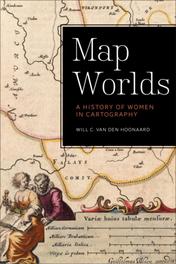Cartography

Excerpt from the Introduction to Map Worlds: A History of Women in Cartography by Will C. van den Hoonaard
Behind some eight thousand contemporary women from around the world stand not only more than five hundred years of history, but also one of the most popular cultural productions in the world: maps. The world of mapmakers is somewhat known to us, but we have only a microscopic knowledge about the involvement of women in map-making. Map Worlds has set itself the task of recovering these women from history. No less significantly, it also recounts the experiences of women with contemporary cartography. Oftentimes, the world of women cartographers seems to be hidden, much like the so-called dark side of the moon, but as every thinking person knows, the invisible side of the moon bathes in the sunlight just as much as the one that faces us does.
Few fields have changed as dramatically as cartography. In the thirty-six years between my making my last etch as a cartographic editor at Falk-Plan (a European map company) in 1966 and my re-entry into the world of cartographers— this time as a social scientist—the field has become unrecognizable. This awakening was a compelling one, for it demonstrated the earthquake-like technological shifts within cartography beyond anyone’s imagination. As a social scientist, I began wondering about the social organization of cartographers—their world, their culture, and their habits. Had these changed drastically as well? As a modern individual, I wanted to apply the contemporary pincer of analysis: What role does gender play in all of this? I had originally envisioned Atlas Shrugged as a title for this book, but had Atlas truly shrugged? Was it a momentous shrug, signifying a radical departure of the old ways? Or was it a shrug of the kind that said,”So what?” This is one of the themes of this book: Have the technological changes that captivated cartography over the past thirty-six years also been reverberating through the organization and lives of women who are drawn to this field?
It is only through the recent passage of time that map librarians, cartographers, map collectors, and historical cartographers have begun to consider more explicitly the role of women in map-making. Part of the awakening process involves fresh research on women who have made important or interesting contributions to cartography (see, for example, Steward, 2001). 1
I have identified three strands of research interests. One strand explores pockets of cartography where women have been particularly active and have contributed significantly to the field in the historical sense. This strand represents a recuperative history of women in cartography.
The second strand concerns itself with contemporary women pioneers in cartography starting around 1880 and up to the present. This strand offers vignettes (brief biographical sketches) of twenty-eight women who were (or are) pioneers or major advancers of cartography. The vignettes describe their parentage, education, careers, contributions to cartography, and anything else that would explain the circumstances of their place and time in cartography.
The third strand deals primarily with the experiences, problems, and obstacles contemporary women face in cartography. This strand also looks behind the social organization of cartography as the backdrop of those experiences.


